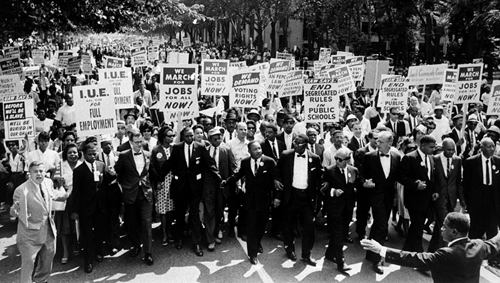Foundation of the Federal City The
US Constitution, ratified in 1788, provided for “a District (not
exceeding ten Miles square) as may, by Cession of Particular States…,
become the Seat of the Government of the United States.” Layout and Design In
1790 George Washington selected Pierre Charles L’Enfant, a French
engineer, to lay out the city. The plan was influenced by Versailles and
the city of Paris. War of 1812 The
United States declared war on Britain in 1812, seeking freedom of
marine trade and the security of US seamen. In 1814 British troops
entered the capital and burned government buildings, including the White
House and the Capitol. If it had not rained, the whole city might have
burned.

The British burn Washington, 1814
Expansion Thomas
Jefferson began western expansion by organizing the Lewis and Clark
expedition in 1803. The C&O Canal and the Baltimore and Ohio
Railroad provided commerce through the mountains and a period of
prosperity. New states were added to the Union, and bitter divisions
arose connected to the issue of slavery. Civil War Conflict
between the Union and the seceding southern states began on April 12,
1861, and plunged Washington and the nation into crisis. Union
supporters, joined by thousands of blacks escaping slavery in the South,
doubled the city’s population in four years. Although threatened, the
city was never taken by Confederate troops, and when the war ended in
1865, Washington was unharmed.

Civil War victory parade
McMillan Plan The
McMillan Plan of 1901, named for its congressional supporter, Senator
James McMillan, was the first application of city planning in the US. It
created much of the layout of the Mall and President’s Park seen today. New Deal The
Roosevelt era (1933– 1945) brought tremendous growth to the city.
Efforts to bring the nation out of the Great Depression increased the
size and number of government agencies, and provided direct funds for
construction. Most of the buildings in the Federal Triangle, the
completion of the Supreme Court, and the National Gallery of Art were
New Deal works. World War II More
than 10 percent of the US population of approximately 115 million was
in uniform at the peak of the war, and the central management of these
troops remained in Washington. March on Washington On
August 28, 1963, African-American leaders led 250,000 people to rally
in front of the Lincoln Memorial in support of equal rights. Dr. Martin
Luther King, Jr.’s eloquence in expressing his dream for America, along
with the size of the march, gave strong impetus to the struggle for
justice for all races.

March on Washington
Home Rule The
federal government’s policy of maintaining full control over the city
was modified with the Home Rule Charter in 1973. This legislation gave
the city the power to elect its own mayor, city council, and school
board.
Top 10 Citizen Rights of the Constitution
Inherent Rights Freedom of religion, speech, the press, assembly, and seeking redress of citizen grievances. Legality of Arms The right of the people to keep and bear arms. Quartering of Soldiers Freedom from housing soldiers in private homes in peacetime and in war, except as prescribed by law. Unjustified Searches Freedom from unreasonable search and seizure of people, houses, and effects without a warrant. Limits on Prosecutors A
grand jury indictment is required before trial; a person cannot be
tried more than once for the same crime; a person cannot be forced to
testify against himself; a person’s property cannot be confiscated
without compensation. Protection of the Accused Accused
persons will be given a trial by a jury of peers, be informed of the
charges, be able to confront witnesses, and be represented by counsel. Civil Case Jury Trial In common law, parties have a right to a trial by jury. Unjust Punishment The government cannot require excessive bail, impose excessive fines, or use cruel or unusual punishment. Limited Scope The stated rights do not limit other rights. State Powers All powers not granted to the US government belong to the states.
|